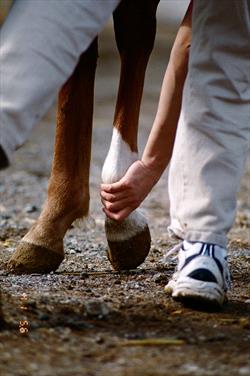Bob Judd, DVM, DABVP (Equine Medicine), DABVP (Canine and Feline Practice)
Exam of horse's hind leg/foot

Dr. Yogi Sharp, DipWCF, BSc Hons., based in Brighton, England, and founder of The Equine Documentalist, indicates in the publication The Horse that when a horse’s hind hooves are out of balance, this could mean poor posture, leading to other difficulties for the horse.
Abnormal trimming of a horse’s hind feet could contribute to a cycle of issues that could cause problems all the way up the rear legs to the back, neck, and even the head.
Specifically, a long toe and low heel conformation cause horses to have a so-called “canted-in” or “standing under” posture and can even be linked to jaw pain.
As a farrier, Dr. Sharp says that he regularly manages horses with a canted-in posture in which their hind feet are pulled up under the trunk. This is common when a horse has low heels and long toes and is called abnormal compensated posture, requiring increased effort of the horse's muscles to maintain and can lead to muscular pain. He said all the horses he works with that have poor hind-foot balance also have terrible posture, and he believes some of this is due to domestication.
In one study, 12 horses with negative plantar angles were examined. This abnormal condition is when the back of the coffin bone is lower than the front of the coffin bone. The 12 subject horses were all standing with their back feet further forward than normal, and Dr. Sharp trimmed and shod the horses to create a straight hoof pastern axis by using wedge pads.
The researchers found significant improvement in angles and posture after treatment, concluding that the position and orientation of the rear hooves can affect the positioning of other joints.
The hind feet are commonly overlooked in horses as most of the focus is on the front feet. From this research, it is concluded that a horse’s hind feet need to be examined more closely, and if long toes and low heels are noted, a change in conformation could positively affect the entire horse.